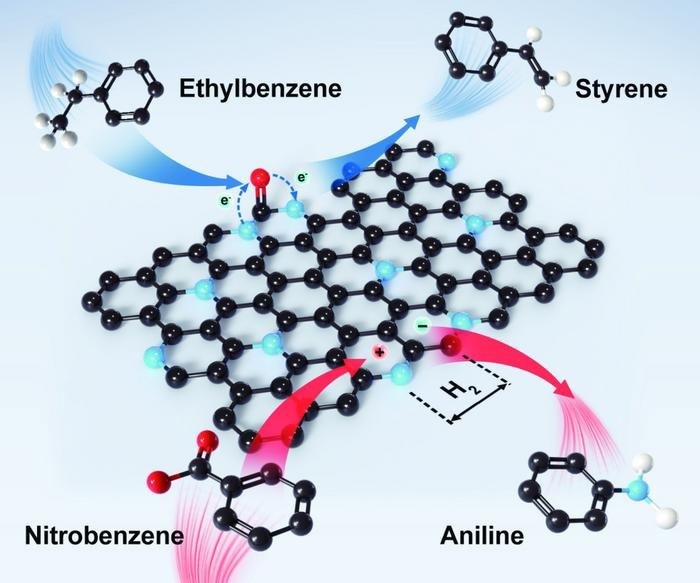Recent years have seen the rise of carbon-based catalysts, particularly nitrogen-doped nanocarbons, as dependable, sustainable substitutes for the metal catalysts that have long been employed to promote chemical processes. To learn more about the precise function that nitrogen plays in carbon-based materials and to investigate the reaction mechanisms of these catalytic systems, researchers from Fuzhou University’s Key Laboratory of Advanced Carbon-Based Functional Materials (Fujian Province University) synthesized nanocarbons from guanine molecules.
 Scientists from Fuzhou University obtained a set of nanocarbons through self-assembling guanine molecules. Besides exhibiting intriguing properties, including relatively stable surface oxygen groups and high nitrogen content, the presence of multiple hydrogen bonds in guanine enabled the formation of a two-dimensional nanosheet with controllable types of nitrogen dopants. The nitrogen content can be finely tuned from approximately 5 to 30 percent, while the oxygen content is kept at a consistent 4 percent. Image Credit: Zailai Xie; Fuzhou University
Scientists from Fuzhou University obtained a set of nanocarbons through self-assembling guanine molecules. Besides exhibiting intriguing properties, including relatively stable surface oxygen groups and high nitrogen content, the presence of multiple hydrogen bonds in guanine enabled the formation of a two-dimensional nanosheet with controllable types of nitrogen dopants. The nitrogen content can be finely tuned from approximately 5 to 30 percent, while the oxygen content is kept at a consistent 4 percent. Image Credit: Zailai Xie; Fuzhou University
The research team explained how various forms of nitrogen might alter the activity of oxidative dehydrogenation, a crucial step in the transformation of inert substances into reactive nanocarbons.
On February 4th, 2023, the study was published in Carbon Future.
The study offers theoretical guidance for creating highly effective carbon catalysts, which could advance clean energies converted from renewable resources in industries like plastics, medicine and rubber.
Zailai Xie, Study Author, Fuzhou University
Doping carbon materials with heteroatoms like nitrogen can alter the carbon’s characteristics. This method has sparked widespread curiosity, prompting academics to study potential advantages. Nitrogen doping, in particular, has shown to be an extremely effective approach for developing new materials for carbon dioxide collection, energy conversion, energy storage, and other applications.
Despite the advances made in the realm of nitrogen doping, certain critical questions remain unsolved. For example, the performance of nanocarbon materials is significantly affected by functional groups of atoms on the surface; however, nanocarbon materials have unpredictable surface functional groups, complicating the identification of active spots for various types of reactions.
Xie added, “This behavior hinders our understanding of the intrinsic role that nitrogen dopants play in improving catalytic activity and determining the catalytic mechanism.”
Xie believes that more regulated and well-characterized catalysts are required to improve the area of nitrogen-doped nanocarbon catalysis. This would enable researchers to separate the impact of individual nitrogen species on catalytic efficiency.
The Fuzhou University research team created a technique to manage surface functional groups, especially nitrogen and oxygen groups, precisely during the creation of nanocarbon catalysts to achieve this objective.
By self-assembling guanine molecules, a compound present in fish scales and guano, the researchers were able to produce a set of nanocarbons. They then heated the resultant material in the absence of oxygen.
Inspired by the supramolecular self-assembly of related nucleobases, such as guanosine, and biological components, such as guanine, this synthetic method presents an interesting way to produce ordered nanomaterials. These molecules have multiplex binding sites, such as π-stacked and H-bonded ones, which help build functional supramolecular assemblies.
Due to its widespread distribution in the biogenic photonic structures of a wide range of living creatures, guanine comes in a variety of sizes and forms, such as prisms, irregular polygons, hexagonal plates, and square plates.
The multicolored optical phenomena seen in fish scales, spider bodies, and animal eyes are a result of the minute differences in guanine crystal shape. But nothing is known about how precisely organisms regulate the shape of their biogenic guanine crystals.
Even though guanine crystals have amazing capabilities, regular guanine crystals that nearly resemble biological conditions cannot yet be artificially produced via a chemical synthesis process, and they cannot be converted into useful carbon compounds.
“The synthesized carbons exhibited unique and intriguing properties, including relatively stable surface oxygen groups and high nitrogen content,” Xie stated.
Furthermore, the construction of a two-dimensional nanosheet with controlled forms of nitrogen dopants was made possible by the numerous hydrogen bonds found in guanine. It is possible to regulate the nitrogen level precisely, ranging from around 5% to 30%, and maintain a constant oxygen content of 4%.
Xie further stated, “This unique property makes guanine an ideal proof-of-concept precursor for construction model catalysts that can lead to in-depth understanding of the role of high nitrogen dopants in nanocarbon catalysis.”
The researchers experimented with dehydrogenation and hydrogenation processes, in which hydrogen molecules are removed from or added to a larger molecule, to better investigate the structure-function correlations.
The experiments showed that the various forms of nitrogen present in the nanocarbons—graphitic and pyridinic nitrogen, for example—act as modulators of electron donation and withdrawal, respectively, allowing the nanocarbons’ oxidative dehydrogenation activity to be adjusted.
Xie concluded, “As an efficient, metal-free catalyst, we have unraveled the roles of nitrogen dopants in both dehydrogenation and hydrogenation for the first time. We believe that our findings provide valuable insights into the physical-chemical reaction mechanisms of nitrogen-doped carbon catalytic systems and offer theoretical guidance for the synthesis of highly effective carbon catalysts.”
The Natural Science Foundation of Fujian Province and the National Natural Science Foundation of China are funding the study.
Fuzhou University’s Xinying Lin, Xiaoyan Huang, Yiquan Chen, Sen Lin, Xing Huang, and Xuefei Zhang are among the other authors.
Journal Reference:
Zhang, X., et. al. (2024) Identification of role of nitrogen dopants in nanocarbon catalysis. Carbon Future. doi:10.26599/CF.2024.9200008.